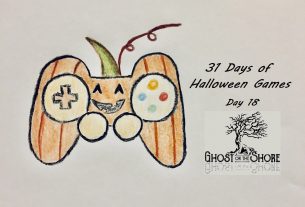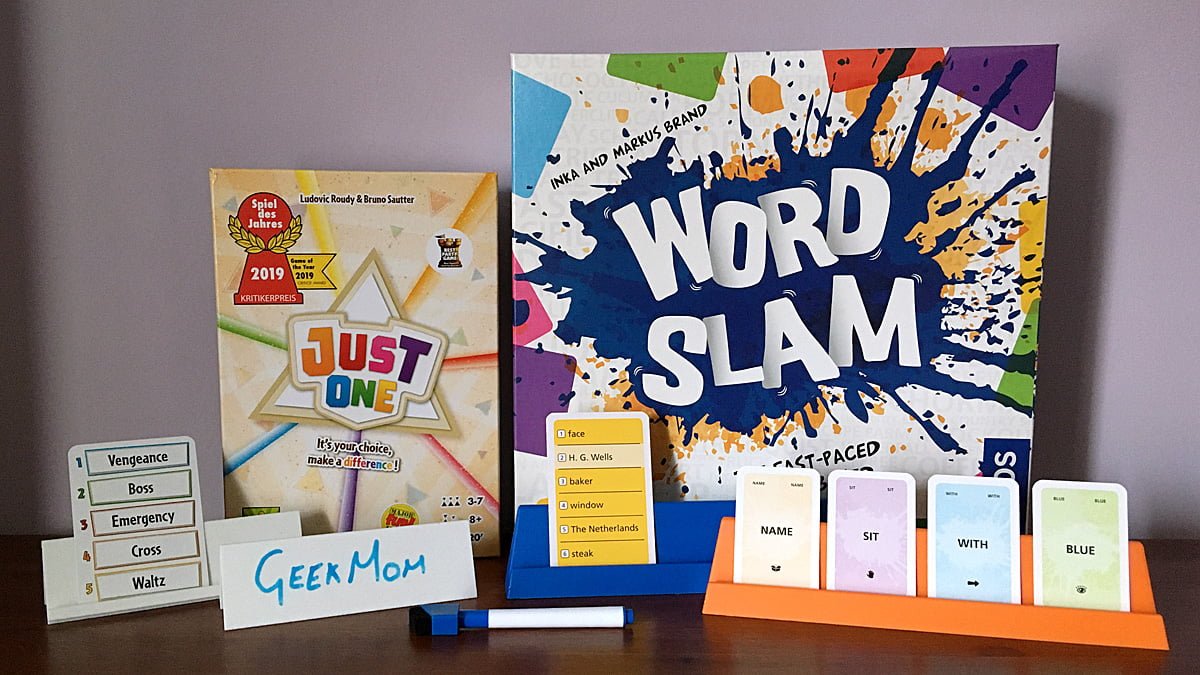
What Are Just One and Word Slam?
Just One and Word Slam are two party-style word games that can be played with large groups as well as small ones. While you might be familiar with Just One—it won the Spiele Des Jahres in 2019—Word Slam is currently less well known but equally fun to play.
Just One is suitable for three to seven players aged eight and above.
Word Slam is suitable for three or more players aged 12 and above, although I have played successfully with my ten-year-old.
Please note: This post contains affiliate links.
What’s in the Box?
Just One
- 110 Word Cards
- 7 Easels
- 7 Wipe-Clean Marker Pens
- Rulebook
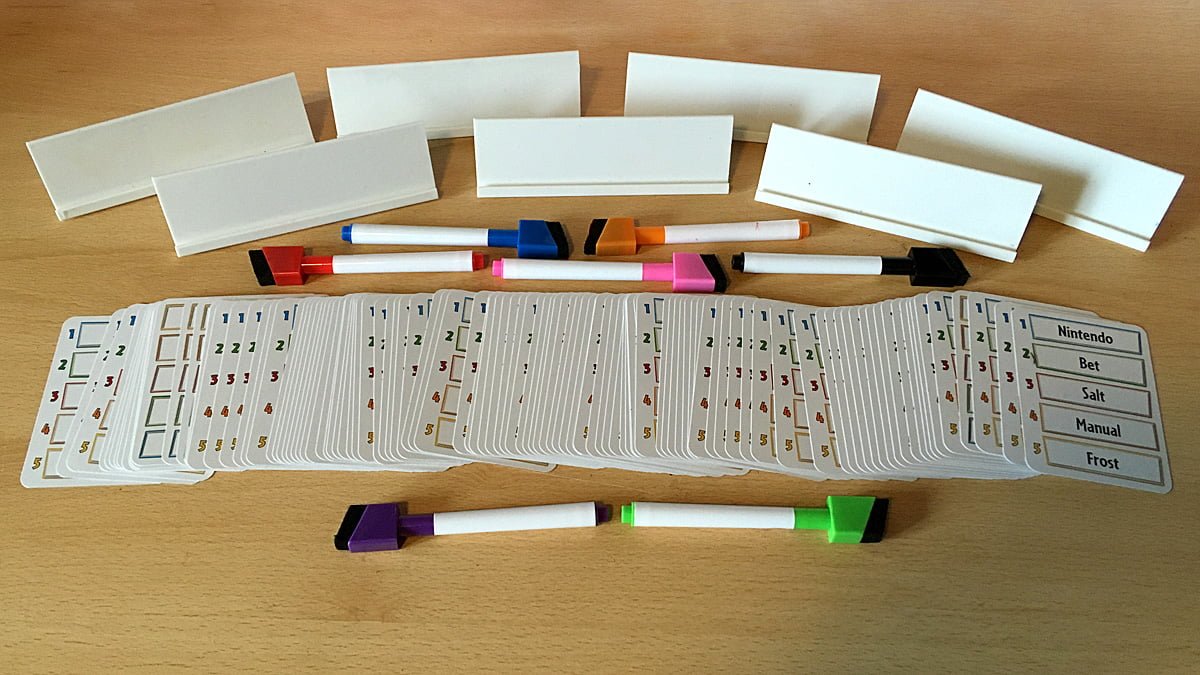
I liked the components of Just One a lot. All the Word Cards contain five Mystery Words, which means that there are well over 500 words to guess here, giving the game a lot of replayability and the cards are really great quality. While there are a lot of plastic components, these are necessary for the game and couldn’t be replaced with non-plastic options easily because using paper to write out your clue words is likely to have more of an environmental impact in the long run. The box does have a plastic insert tray, but it is well-sized to fit the components.
Word Slam
- 200 Answer Cards
- 210 Story Word Cards
- 4 Card Holders
- Die
- Hourglass
- Rulebook

I was generally less impressed with the components and packaging for Word Slam. The box is very large with another plastic insert and lots of wasted space—it could have been packed into something at least one third smaller. Again, there are multiple plastic components, and the Card Holders at least could have been made out of more environmentally friendly materials, as it is they feel rather cheap.
On the positive side, the Answer Cards (also great quality) each contain six words, giving a total of 1200 words to guess, so Word Slam has even more replay potential that Just One.
How Do You Play Just One and Word Slam?
Just One
The title of Just One gives you a clue as to how the game is played. Each round involves a player having to guess just one word, with just one guess, while the other players getting to write just one word. Just One is a cooperative game with all players on the same team.
Setup
Each player receives a wipe-clean marker pen and an easel. Randomly draw 13 cards to create a face-down deck in the middle of the play area and return the other cards to the box.

Choose one player to be the first active player and the game is ready to begin.
Gameplay
The active player takes the top card from the deck and places it facing away from them on the easel so they cannot see any of the words on it. They then pick a number between one and five (you could add a die to the game for this if you wanted) to tell the other players which Mystery Word they must provide a clue for.
All the non-active players then write down a single word on their easels that they think will provide a clue to the Mystery Word. They must do this without communicating with one another in any way. In a three-player game, all players have two easels and the non-active players write one word on each easel.
The single word clues may include digits, numbers, acronyms, onomatopoeia, and special characters such as £ or $ signs. Some clues are invalid, however, such as writing the Mystery Word in a different way (e.g. shurt for shirt) or in another language (e.g. poisson for fish). Clues can also not include words from the same family as the Mystery Word (e.g. princess for prince), made up words, or words that are phonetically identical to the Mystery Word (e.g. whether for weather).

Once all the non-active players have written a clue, the active player closes their eyes and the others compare their clues. At this point, any invalid words are removed from play, as are any identical words that were written by different players. Variants of a word from the same family are considered identical, as are plurals (e.g. dog and dogs), gender differentiation (e.g. lion and lioness), and spelling mistakes.
Assuming at least once clue remains, the easels are turned to face the active player who opens their eyes and then tries to guess the Mystery Word from the clues. They only have one guess. If they are successful, the current card is played face-up beside the draw deck. If they are incorrect or cannot answer and skips their turn, the card is returned to the box. If no clues were left for the active player to guess from, this is counted as a failure or a skipped turn and the current card goes back into the box.
Play then continues to the next round with a new active player until all cards have been played.
Scoring
Once all thirteen Mystery Words have been played, the players count the number of successfully guessed cards in the face-up pile remaining on the table and compare that number to this chart to see how well they did.
Word Slam
In Word Slam, players are divided into two teams who compete against one another to be the first to guess the chosen word, name, or term from the current Answer Card.
Setup
Players split into two teams (they do not need to contain an equal number of players) with each team on one side of a table. Each team received two Card Holders and a deck of 105 Story Cards with their team color on the back—either blue or orange. The Story Cards for each team should be divided into stacks by their colors or the symbols on the front and the die and hourglass placed nearby.
A number of Answer Cards are drawn from the deck depending on how many rounds are to be played. The instructions recommend 10 rounds for an introductory game, 15 for a three-player game, 21 for a four to five-player game, and 25 for a game with six or more players, but this number can be altered to suit your group’s preferences.
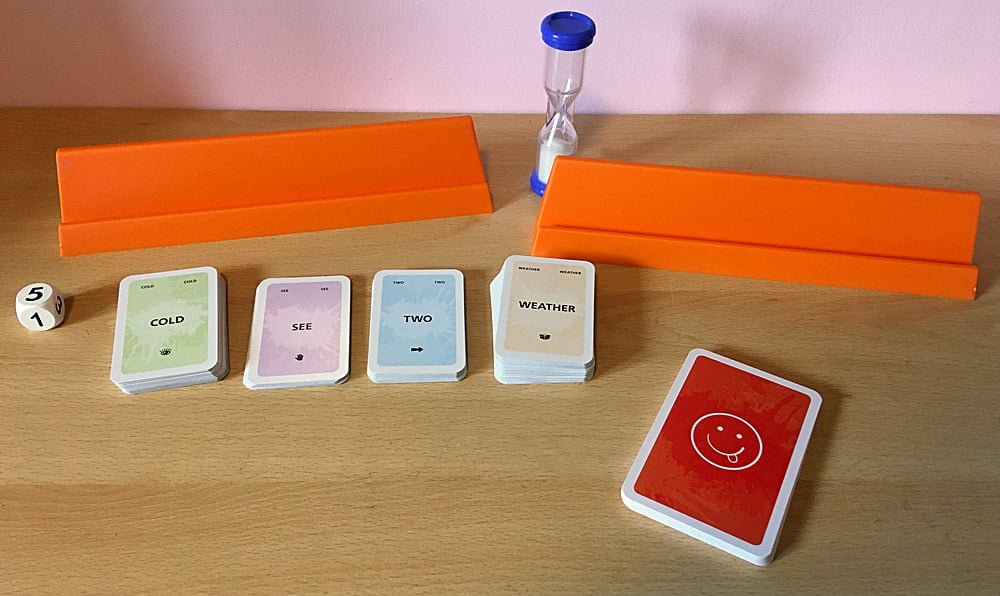
The oldest player on each team is the designated first storyteller and the deck of Answer Cards placed where both teams can reach it, along with the die and the hourglass.
Word Slam is now ready to play.
Gameplay
In round one, the Blue Team’s storyteller is in control of the die and the hourglass. They begin the first round by rolling the die and the Orange Team’s storyteller takes the top card from the top of the deck of Answer Cards. Both storytellers look at the Answer Card and find the word or phrase that corresponds with the number just rolled. The two storytellers then agree if they are happy to play that word (one may feel that the word is too difficult or unknown to their team, in which case the die can be rolled again until a word is agreed upon). Once a word is agreed, the card is placed face-down beside the draw pile. One storyteller says “Word” and the other replies “Slam.”

The storytellers then begin to pull out words from their piles of Story Cards that they feel will lead their team to guess the correct answer, placing these cards on their Card Holders. The other team members are free to talk with one another but should consider that the other team might be listening in as they are trying to guess the same word. The storytellers may not communicate in any way except vis the Story Cards and thus must not speak, sing, hum, gesture, act out, etc, however, they may point to a card that they feel is particularly important. The one exception to this is that if the Answer the teams are trying to guess is a two-part word (or larger), the storyteller may explain that the left-hand Card Holder relates to the first word and the right-hand Card Holder relates to the second word.
During the round, the storyteller may reorder Story Cards, remove them, and add new ones at any time. They may also use as many Story Cards as will fit on the Card Holders, but they must not partially cover words to reveal letters or word fragments that form part of the answer.

At any point, the storyteller in charge of the hourglass for the round may decide to commence timing. They announce this to everyone and turn the hourglass over. The teams now have until it runs out to guess the correct word. If they don’t, the round ends without a winner. This is useful in rounds that are dragging on because both teams are struggling to guess the answer.
Once a team guesses correctly, the round ends. The winning team takes the current Answer Card and places it face down on their play area. The storytellers change to the next player in both teams, and control of the die and hourglasses passes to the opposite team.
Scoring
Rounds continue until all the Answer Cards in the draw pile have been played and the team who has won the most cards is the winner. In the event of a tie, draw one more Answer Card from the box and play a tie-breaker round.
Verdict
I really enjoyed both Just One and Word Slam. Even though the two games seem very similar on paper—helping another player guess a specific word or phrase by giving them another word or words as clues—the two have very different mechanisms that make them completely different experiences.
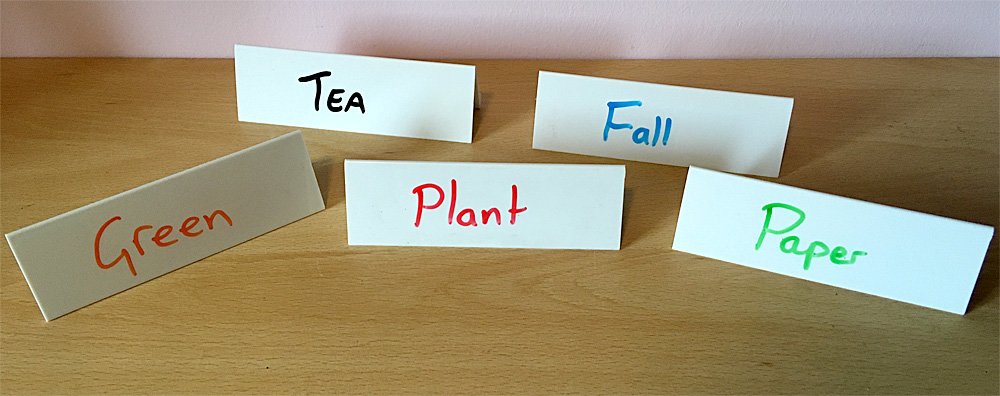
I enjoyed both games equally, although I did find Just One easier to play and—crucially—to explain. Word Slam‘s far more convoluted rules made it much less easy to understand at first and we ended up playing our first game with friends completely wrong! Once you have the hang of it, it is an easy game to play, but the instruction sheet could definitely use improvement. At the opposite end of the spectrum, Just One‘s instructions were very clear and easy to understand right from game one.
Both these games are fantastic for developing language skills and I have enjoyed playing them with my ten-year-old and his friends. They both get you to think about ways of explaining ideas and concepts to others, either thinking of the words yourself (warning: ten-year-olds come up with some very abstract “clues” when playing Just One) or by selecting words from a pre-established collection of descriptions—very different skills but equally valuable ones, especially for creativity. Word Slam will certainly stretch your creativity to the max, whereas Just One is more about trying to judge your fellow players to try and avoid accidentally writing the same clues. If you write an obvious clue then of course, it will match someone else’s clue, or will it if they’ve thought the same way and chosen to go abstract instead?

If I had to pick only one of the two games to buy, Just One would probably be the overall winner (it did win the Spiele des Jahres for a reason), but there is a big part of me that enjoys the mechanism of Word Slam a little more because of the extra challenges it presents. Both are great games that I would recommend to anyone who enjoys word games with a group and who is looking for a new challenge.
The answer to the Just One puzzle above was: Leaf.
GeekMom received a copy of this item for review purposes.


